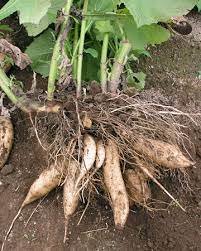Yacon
Names: Yacon, Smallanthus sonchifolius
Flavour: Yacon roots have a sweet and juicy flavor, similar to a crisp apple or pear, with hints of watermelon or honeydew melon.
Growing season: Yacon is typically grown in regions with mild climates and a long growing season. It requires approximately 6 to 8 months of frost-free weather to develop fully.
Native region: Yacon is native to the Andean region of South America, particularly Peru and Bolivia.
Traditional recipe: Yacon can be enjoyed raw or cooked. One popular way to enjoy it is by slicing it into thin rounds or sticks and consuming it as a refreshing and healthy snack. Yacon can also be added to salads, stir-fries, or even juiced to make a nutritious beverage.
Health properties: Yacon is known for its potential health benefits. It is low in calories and a good source of dietary fiber. Yacon roots are rich in inulin, a type of prebiotic fiber that promotes gut health and supports beneficial gut bacteria. Yacon also contains antioxidants, vitamins, and minerals, including potassium and vitamin C.
Growing technique: In the west of the island, Mark Forskitt cultivated Yacon. Yacon plants prefer well-drained soil and full sun. They can tolerate a range of soil types but perform best in loose, fertile soil. Yacon is typically grown from rhizomes or tubers, which are planted in spring after the last frost. The plants require regular watering to keep the soil consistently moist. Yacon can reach heights of up to 6 feet (1.8 meters) and develops large, broad leaves. The tubers are harvested in autumn or early winter, after the foliage has died down. It is important to store the harvested Yacon roots in a cool, dark place to maintain their freshness and quality.
